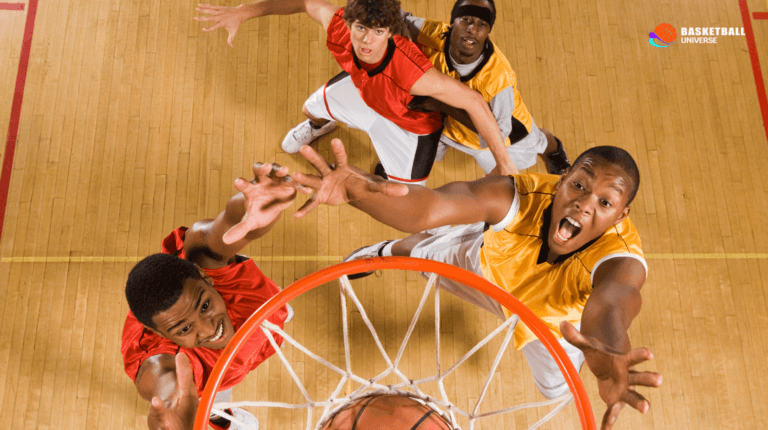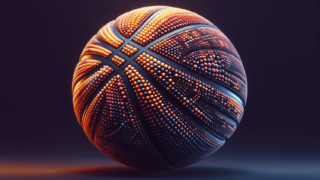
As basketball enthusiasts, we’re always eager to get out there and improve our game, no matter where the court may be. But when it comes to using that pristine indoor basketball on an outdoor court; is it a slam-dunk idea or a way to foul up your favorite game ball? In this fun and professional blog post, we’ll explore the age-old debate of whether it’s okay to use an indoor basketball outside, and what potential consequences this could have on your gameplay and the ball itself. So, lace up your sneakers, grab your trusty hoop, and let’s jump into the nitty-gritty details!
Is It Bad to Use an Indoor Basketball Outside?
Yes, using an indoor basketball outside is generally considered to be a bad idea. Indoor basketballs are made of softer materials optimized for indoor courts, while outdoor basketballs are designed with a more durable rubber to withstand rougher surfaces. Using an indoor basketball outside can cause it to wear out more quickly, lose its grip, and impair its overall performance on indoor courts. It’s better to use the appropriate ball for each environment to ensure the best gameplay and longevity of the equipment.
Understanding the Differences Between Indoor and Outdoor Basketballs
The first step in knowing whether it’s bad to use an indoor basketball outside is understanding the differences between the two types of balls. A key distinction lies in the materials used in their construction, affecting their performance on various court surfaces.
Indoor Basketballs
Indoor basketballs are typically made from softer materials, such as composite leather or genuine leather, which provide a better grip and feel for hardwood floors. These materials also offer better moisture absorption, which is essential in maintaining control during an intense, fast-paced game indoors. However, these soft materials are more susceptible to damage when exposed to rough outdoor surfaces, potentially reducing their lifespan and performance.
Outdoor Basketballs
On the other hand, outdoor basketballs are constructed with more durable materials, such as rubber or a firmer composite material. These materials withstand scuffs, scrapes, and wear from outdoor surfaces, like asphalt or concrete. The outer layer generally features a texture optimized for grip on uneven surfaces, allowing for consistent performance outdoors. While these basketballs can endure the hard knocks from outdoor courts, they may feel different in your hands compared to an indoor basketball.
Dual-use Basketballs
For those who frequently switch between indoor and outdoor courts, some basketballs on the market are designed for both environments. These dual-purpose basketballs typically feature a blend of indoor and outdoor materials, offering durability while retaining an acceptable grip and feel for indoor courts. If you regularly play in both settings, investing in a dual-use basketball could be an ideal option.
The Impact of Using an Indoor Basketball Outdoors
Now that we understand the differences between indoor and outdoor basketballs, let’s delve into the consequences of using an indoor basketball on outdoor courts.
Durability and Lifespan
As mentioned earlier, the softer materials used to construct indoor basketballs are less resilient when exposed to outdoor courts. Outdoor courts like asphalt or concrete are rougher and can cause significant wear and tear on the ball’s surface, including scuffs, scratches, and even punctures. As a result, the lifespan of an indoor basketball could be dramatically reduced when used outside.
Performance
Aside from diminishing durability, using an indoor basketball outside can also have a negative impact on its performance. Over time, the rough surface of outdoor courts can erode the ball’s pebbling – the tiny bumps on the ball’s surface – and thus, decrease grip quality. When you return to playing indoors, this wear on your ball will reduce your ability to handle it effectively, making dribbling, shooting, and passing less precise.
Impact on Basketball Skills
Another vital consideration is the potential impact on your basketball skills when using an indoor basketball outside. By working with a basketball with a degraded grip and change in feel, you may inadvertently alter and adapt your shooting technique, dribbling style, and passing accuracy to compensate for the ball’s condition. These adjustments can be harmful to your overall skills, potentially causing inconsistencies and instabilities in your game when transitioning between different balls for indoor and outdoor play.
Caring for Your Indoor Basketball
To ensure the longevity of your indoor basketball, it’s essential to employ proper care and maintenance practices. Here are some tips to keep your indoor basketball in top-notch condition:
Storage
Always store your indoor basketball in a cool, dry place when not in use. Excessive heat, cold or moisture can harm the ball’s materials and construction quality.
Cleaning
Regularly clean your basketball with a slightly damp cloth to remove dust, dirt, and sweat that builds up during games. Avoid soaking the ball or using harsh chemicals, as this could damage it.
Inflation
Maintaining proper inflation of your basketball is crucial in ensuring its performance and longevity. Routinely check the ball’s air pressure and adjust as necessary to match the recommended PSI specified by the manufacturer. Over or under-inflating your ball not only affects performance, but it could also damage the ball’s internal structure.
Tips for Outdoor Basketball Use
While it’s best to have separate basketballs for indoor and outdoor play, if you find yourself lacking a suitable outdoor ball, consider the following tips when using an indoor basketball outside:
Choose a Less Abrasive Outdoor Court
Opt for outdoor courts with surfaces that are smoother and less abrasive, such as painted or tiled courts. These surfaces will cause less wear and tear on your basketball compared to rougher, untreated asphalt or concrete courts.
Use a Dual-Purpose or Older Ball Instead
When faced with outdoor gameplay, prioritize using a dual-use basketball, as it is designed to handle both environments. Alternatively, opt for an older basketball that isn’t designated for indoor use. By saving your indoor basketball for its intended environment, you’ll preserve its longevity and performance.
Limit Exposure to Outdoor Elements
Minimize the exposure of your indoor basketball to wet, dirty or rough outdoor surfaces as much as possible. Reducing time on outdoor courts and cleaning your ball after each use can help prevent damage and maintain its integrity.
Investing in the Right Basketball for Your Needs
When deciding on the perfect basketball for your needs, consider your playing habits, court locations, and personal preferences. A good-quality outdoor ball that suits your requirements could be a worthwhile investment in the long run. Some popular options include:
Spalding NBA Street Outdoor Basketball
This basketball is a popular choice for outdoor players, featuring a sturdy rubber surface designed to handle the wear and tear of outdoor courts. It comes in different sizes to match your playing level and style.
Wilson Evolution Indoor/Outdoor Basketball
If you’re looking for a dual-purpose basketball, the Wilson Evolution offers a versatile option. With a cushioned surface providing a good grip and feel, this composite leather ball is suitable for both indoor and outdoor courts.
Under Armour 495 Indoor/Outdoor Basketball
The Under Armour 495 is another versatile option for those that play in both settings. With a composite leather cover and a textured surface, it offers a solid grip and increased durability for rough surfaces.
Conclusion
Is it bad to use an indoor basketball outside? In short, yes. The potential damage to the ball’s surface and the impact on performance make it an inadvisable choice. By investing in separate basketballs, or a versatile dual-purpose ball for both indoor and outdoor play, you can ensure your equipment withstands the test of time and maintains its quality. Happy hooping!
Choosing the Right Basketball Size and Weight
Aside from selecting the right type of basketball for the court surface, it’s essential to consider the size and weight of the ball. Basketball sizes are standardized and vary by age group and gender. Using the appropriate size ball for your age and skill level can optimize your performance and enhance your overall gameplay.
Size 5: Youth (27.5 inches)
Size 5 basketballs are designed for younger players, typically between the ages of 7 to 12. These balls are lighter and smaller than regulation basketballs, allowing younger hoopers to develop their skills and gradually transition to larger basketballs as they grow.
Size 6: Intermediate (28.5 inches)
Intermediate basketballs, known as size 6, cater to young players aged between 12 to 15 and are the standard size for women’s basketball in high school, college, and professional levels. The intermediate ball provides a balance between comfort and performance for developing players and female athletes.
Size 7: Official (29.5 inches)
Size 7 is the official basketball size used in high school, college, and professional men’s games. This standard size ball provides the best performance for advanced players who are refining their skills and competing at higher levels.
Maintaining Performance across Different Court Surfaces
Translating your basketball skills from indoor courts to outdoor courts while maintaining consistently high-level performances can be challenging. Here are a few tips to help you stay on top of your game, regardless of the environment.
Build a Strong Foundation
Developing a strong foundation in basketball fundamentals is critical to maintaining a consistent level of play. Focus on dribbling, shooting, and passing techniques, and ensure that you have well-rounded skills that remain effective on various court surfaces.
Stay Engaged
Communicate with your teammates and stay aware of your surroundings when playing in different environments. Maintaining a high level of engagement on both indoor and outdoor courts can help you stay focused and adapt to diverse playing conditions.
Adapt to Changing Conditions
When transitioning between court surfaces or using different types of basketballs, be prepared to make minor adjustments to your game. Assess how the ball and the court’s surface might affect your style, and be willing to change your approach if needed.
Extend Outdoor Basketball Life with Proper Care
While indoor basketballs may not fare well outdoors, it’s crucial to take care of your outdoor basketball as well. Here are some suggestions to sustain its durability and longevity.
Rotate Usage
Rotate the usage of more than one outdoor basketball. This practice helps distribute the wear and tear evenly and allows for a break-in period where the ball’s grip and bounce improve.
Avoid Prolonged Sun Exposure
Extended sun exposure can cause your outdoor basketball to fade and lose some of its grip quality. Keep the ball shaded or indoors when not in use to avoid this issue.
Periodic Inspection
Inspect your outdoor basketball regularly for any signs of punctures, leaks, or other types of damage. Addressing these issues early on can help prevent more significant problems in the long run.
Conclusion
Knowing the difference between indoor and outdoor basketballs and their respective advantages and limitations is crucial for choosing the right equipment and maintaining your skills across different environments. Armed with this knowledge, you can now make an educated decision on the ideal basketball for your needs and enjoy the game wherever you may play.
FAQ: Indoor and Outdoor Basketball
If you still have questions about indoor and outdoor basketball use, we’re here to help! Here’s a compilation of frequently asked questions about this subject, along with concise and informative answers to guide you as you navigate the world of basketball.
1. Can I use an outdoor basketball indoors?
Yes, outdoor basketballs can be used indoors, but they may not offer the same grip and feel as indoor basketballs. While it’s not as damaging as using an indoor ball outside, using an outdoor ball indoors may not provide the optimal gameplay experience.
2. How long should an indoor basketball last?
An indoor basketball can last for several years with proper care and maintenance, assuming it’s not consistently used outdoors. The lifespan of an indoor basketball depends on factors like usage frequency, storage conditions, and proper inflation.
3. How often should I replace my indoor basketball?
There’s no specific timeline for replacing an indoor basketball; it depends on the ball’s condition, usage, and your preferences. If the ball shows significant wear, loses inflation too quickly, or no longer provides adequate grip, it’s likely time for a replacement.
4. How do I clean my indoor basketball?
Use a slightly damp cloth to gently clean your indoor basketball, removing dust, dirt, and sweat that accumulates during games. Avoid submerging the ball or using harsh chemicals that could damage its surface.
5. Can I use an indoor/outdoor basketball for competitive play indoors?
Indoor/outdoor basketballs can be used for competitive play indoors, but they may not have the same high-level grip and feel as dedicated indoor basketballs. If you’re playing at a relatively high level, an indoor-specific ball is recommended for the best performance.
6. How can I improve the grip on an outdoor basketball?
Breaking in a new outdoor basketball through regular use can help improve its grip over time. Additionally, keeping your hands and ball clean and dry during play can help maintain better control.
7. Can using an indoor basketball outside affect my shooting form?
Yes, consistently using an indoor basketball outside could potentially affect your shooting form. As using the ball on rough outdoor surfaces diminishes its grip quality, you may inadvertently alter your technique to compensate, which could negatively impact your shooting form when using a different ball indoors.
8. What is the best type of basketball for beginners?
For beginners, a dual-purpose indoor/outdoor basketball is often recommended. This versatile ball allows new players to develop their skills in various environments without worrying about damaging a dedicated indoor ball.
9. Are there any specific brands of basketballs that are better for outdoor use?
Brands like Spalding, Wilson, and Under Armour all offer high-quality outdoor basketballs. It’s essential to choose a basketball that best fits your personal preferences and needs for outdoor use.
10. How do I properly inflate my basketball?
Use an air pump with a pressure gauge to ensure proper inflation. Each basketball has a recommended PSI (pounds per square inch) specified by the manufacturer, usually printed on the ball. Inflate the ball to the recommended level to ensure optimal performance and longevity.
11. Can I use a soccer ball pump to inflate my basketball?
Yes, a soccer ball pump with a needle can be used to inflate your basketball. However, be sure to monitor the ball’s air pressure to avoid over-inflating or under-inflating it, which could negatively impact performance and durability.
12. Can playing outdoors help me become a better indoor basketball player?
Playing outdoors can contribute to skill development and overall athleticism, which in turn can make you a better indoor basketball player. However, it’s crucial to remember that using the appropriate basketball for each environment is key to maintaining consistency in your skills.
13. Should I buy separate indoor and outdoor basketballs or a dual-use basketball?
It depends on personal preferences and your basketball habits. If you predominantly play on either indoor or outdoor courts, investing in dedicated basketballs for each surface can be beneficial. However, if you frequently switch between the two environments, a dual-use basketball may be a more versatile and convenient option.
Featured Posts
- No pillar pages found.




